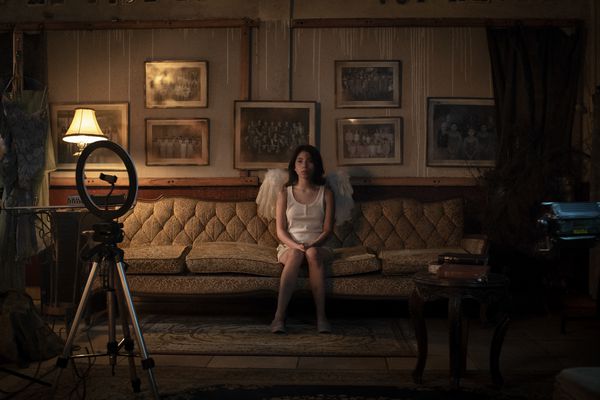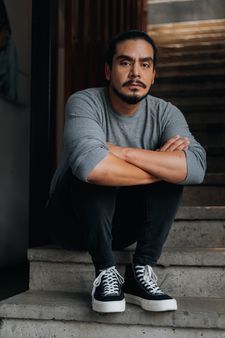 |
| Rita |
It was an incident that shocked Guatemala, claiming the lives of 41 girls, but behind it lay a still more shocking truth. The fire at the Virgen de la Asunción Safe Home (Hogar Seguro) in San José Pinula, in March 2017, was started by the girls themselves in an effort to force staff at the home to release them from a room where they had been locked following an escape attempt. They were desperate to get away from an institution where they had been routinely hired out for rape and abuse.
 |
| Jayro Bustamante |
The story came to worldwide attention in 2020 thanks to Oscar-nominated short Saria, and this year, Jayro Bustamante has explored it in a full length feature film, Rita, using magical realist techniques to give a voice to the victims. The film has been a hit on the international festival circuit , but what really matters to Jayro, as he explained to me, is reaching people in Guatemala itself, where the struggle for justice is still ongoing.
“You know, in this country, the process continues. We don't have much hope about that process because people continue to put labels on the girls, saying that they are not girls but they are delinquents and they are bad people, just dangerous people. That was the storytelling that they wanted to use. And when I say they, I mean those responsible for the tragedy. They want to use it to cut the empathy of the audience. And Rita, the film, is a kind of poetry about the girls. We wanted to give them another opportunity, to say they are magnificent creatures.
“I started my research because the Hogar Seguro case that happened in 2017. After that I started looking for more information in Central America, and I found a lot of similar cases in the whole continent and even in Mexico. And in that moment it was very hard to continue – until the moment that the girls started, in the interviews, talking me about how they protect themselves.
“They protect themselves using magical things, magical stories, you know? It was a very nice discovery. And I decided to go into that, to tell that dark situation. So that was the beginning. And even in the diversity of places that this happened, Rita is built using a lot of experiences of other girls who were in different institutions.
“It was very nice because the first projection that we made in Guatemala, we showed the film to the survivors and to the families of the girls that are not anymore with us. And for them it was so important to have a film that continues talking about their suffering. Not because suffering is a good thing, but because we need to say what they experienced to, in a way, save other girls. So it was a very nice experience because people don't have any particular independent interest or goal. They just want to have a social movement to protect other girls. And I think it was the most beautiful thing that happened to us, during the process of the film.
 |
| Rita |
“Even the actresses, they came to the casting because for sure, they wanted to become an actress and be famous, at the beginning. At the end, when they understood the thematic of the film, they really wanted to become a voice. Not anymore, just an actress. So that was a very nice experience.”
We discuss his decision not to show the sexual abuse directly, which keeps the film from becoming exploitative and makes it more powerful.
“It's a very strange thing because I think that there are four steps in writing a script,” he says. “The first one is when you write the script. The second one is when you shoot it. The third one is when you edit it and finish it. But the last one is when the audience watch the film and they feel what you put in the film. And it was a very plain way of saying that we if children are suffering right now, in a way, that is our responsibility. And everyone knows what that means. I don't need to show them because they know it, and the audience will fill the gaps and the ellipses in a very good way. I think it's happening because we know that we are not taking care of our new generations in a good way.”
I ask him about the visual language of the film, in which the girls are split into groups and dressed like different kinds of magical creatures – Rita, the heroine, is given angel wings – something that use as the basis for a fantastical way of imagining the world.
 |
| Rita |
“That idea came from a very nice situation and a very dark situation. The dark one is the fact that the catalogue that people used to sell the girls existed in different institutions. That was one of the things that I wanted to tell. And the other one was the way to escape very dark reality, and how the girls used their creativity to try to save their interior children, even if they were treated as adults and in the worst way.
“We had 300 actors in the film. They came to my academy and they were trained as actors, but they helped us to develop that magical world. They put a lot of their own imaginations into it and they built their own rooms and they built their own rituals because each one of them had one. And the first cut was four hours and a half. We had each one of the clans very nicely explained, but we had to cut it.”
The scene where they escape was a thrilling but tremendously complicated thing to shoot, he says. It sees them running, dozens at once, through woods and streets, pursued by security guards, and somehow the camera manages to pick out individual stories in all that chaos.
“That was one of the most beautiful scenes that we shared,” he says. Everything in the film is actually based on reality. And when the girls in the Hogar Seguro institution escaped, they escaped in a way like that. I wanted to build that. I remember, in that scene we had 300 girls running into the wood and into the little town. We had the teacher of the academy and we had the psychologists working with the girls at the same time to explain them how to use their emotions and how to use the reality, and just help them to become themselves again after the cut.
 |
| Rita |
“I remember that it was so hard because we didn't have enough psychologists for that scene. And the girls were in a very high emotional situation because they knew – everyone knew – what happened to the real girls. I think I would have needed ten cameras to catch every one of the situations. But it was one of the most important things that we filmed.”
This hard work has been rewarded with praise from critics and audiences alike.
“I'm really happy about the local success, he says. “For sure, the international success is important, but the local success is really what we were looking for. I was so happy because my co producers were in the same line with me, and in Guatemala, the film is really having a very nice reception. People are understanding better what happened in reality, and they are changing the way they think about the girls. Right now we are trying to arrange this parallel distribution that we want, to bring the film to the schools, to the little towns. For sure, I'm happy the film can live outside of the borders, but I think here it is having a very strong reception.”
Rita will be available to watch on Shudder from Friday 22 November.





















